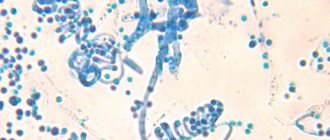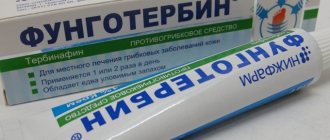| Phenytoin | |
| Chemical compound | |
| IUPAC | 5,5-diphenylimidazolidine-2,4-dione |
| Gross formula | C15H12N2O2 |
| Molar mass | 252.268 g/mol |
| CAS | 57-41-0 |
| PubChem | 1775 |
| DrugBank | DB00252 |
| Classification | |
| ATX | N03AB02, N03AB04, N03AB05 |
| Pharmacokinetics | |
| Bioavailable | 70-100% orally, 24.4% with rectal and intravenous administration |
| Plasma protein binding | 90% |
| Metabolism | liver |
| Half-life | 6-24 hours |
| Excretion | Most with bile, part with urine |
| Methods of administration | |
| orally, parenterally | |
| Other names | |
| Diphenin, Diphenylhydantoin, Dilantin | |
| Media files on Wikimedia Commons | |
Phenytoin
is an antiepileptic drug from the group of hydantoin derivatives, has an anticonvulsant effect without a pronounced hypnotic effect, and is also used as an antiarrhythmic drug and a muscle relaxant.
The mechanism of the therapeutic effect of phenytoin is not completely clear; it is assumed that it is due to the stabilization of the neuronal membranes of the nerve cell body, axons and in the area of the synapse, and as a result, limiting the spread of neuronal excitation and convulsive activity.
The effectiveness of the drug has been clinically tested, phenytoin is included in the list of essential medicines of the World Health Organization[1], as well as in the list of vital and essential medicines approved by Order of the Government of the Russian Federation dated December 7, 2011 No. 2199-r.[2]
Story
In 1908, German chemist Heinrich Blitz synthesized diphenylhydantoin (phenytoin), and in 1937, doctors at Putnam and Merritt discovered the possibility of using phenytoin in the treatment of epilepsy[3][4]. The drug turned out to be more effective than phenobarbital and did not have a depressant effect on the brain.
From the very beginning of the use of phenytoin, information appeared that it has not only anticonvulsant properties. Reports have been published of marked improvements in personality traits, mood, emotional stability, and a sense of comfort in patients taking the drug. Phenytoin has also shown the ability to have a therapeutic effect on other manifestations of dysfunction, especially when combined with changes in the bioelectrical activity of the brain on the electroencephalogram (EEG). However, the use of phenytoin for these therapeutic purposes is very limited due to a significant number of side effects and incompatibility with many other drugs.
Contraindications to the use of Diphenin
Difenin is not prescribed to patients who have the following conditions and diseases:
- Morgagni-Adams-Stokes syndrome;
- Atrioventricular block 2 and 3 degrees;
- Hypersensitivity to the active component of the drug;
- Sinoauricular block;
- Sinus bradycardia;
- Pregnancy and lactation period.
The drug should be taken with caution in patients who have:
- Alcoholism;
- Chronic heart failure;
- Fever;
- Diabetes;
- Cachexia;
- Liver failure;
- Systemic lupus erythematosus;
- Porphyria.
The drug Diphenin affects the speed of human reaction, therefore it is not recommended for people working with heavy machinery and vehicles.
pharmachologic effect
Phenytoin is effective in treating many types of epilepsy and about 50 other diseases, as confirmed by more than 10,000 studies conducted in 38 countries. Described as an effective bioelectric stabilizer. Phenytoin normalizes altered bioelectrical activity at the level of cell membranes and, at the same time, has little effect on the functions of normal cells. Its ability to regulate the functions of biological membranes has been found in the tissues of the brain and spinal cord, autonomic ganglia, peripheral nerves, striated and cardiac muscles, the cardiac conduction system, as well as in the smooth muscles of the intestines and blood vessels. In addition, phenytoin modulates the functions of other cell types, such as neuroglia, endocrine cells, fibroblasts. It has been found to have antihypoxic and antitoxic properties and promote wound healing.
Phenytoin affects the active and passive transport of sodium and calcium ions through the cellular and subcellular membranes of nerve cells. Reduces the level of sodium in the neuron, reduces its intake, blocking the Na+/K+-ATPase of the brain and facilitates the active transport of sodium from the cell. Phenytoin changes the calcium-phospholipid interaction in the cell membrane and reduces active intracellular calcium transport, inhibits the release of neurotransmitter amino acids (glutamate, aspartate) from nerve endings, which provides an anticonvulsant effect. Phenytoin has the ability to inhibit glutamate receptors.
When administered orally, the effect appears within one hour, and when administered intravenously, within a few minutes. In therapeutic doses it has a calming effect, but does not “load” the patient. It has a tonic effect, but is not a psychostimulant. Does not cause physical or mental addiction.
Interactions with other medicinal drugs and other types of interactions
Medications that may increase the level of phenytoin in blood syringes
Amiodarone, antiepileptic drugs (etosuximide, felbamate, oxcarbazepine, metsuximide, topiramate), azoles (fluconazole, ketoconazole, itraconazole, miconazole, voriconazole), capecitabine, chloramphenicol, chlordiazepoxide, disulfiram , estrogens, fluorouracil, fluoxetine, fluvastatin, fluvoxamine, H2-antagonists (eg cimetidine), halothane, isoniazid, methylphenidate, omeprazole, phenothiazine, salicylates, sertraline, succinimides, sulfonamides (eg sulfamethizole, sulphaphenazole, sulfadiazine, sulfamethoxazole-trimethoprim), cyclops din, tolbutamide, trazodone, warfarin, as well as one-time phenytoin tablets and alcohol.
Medications that may alter the effect of phenytoin in blood syringes
Anti-tumor drugs, including combinations (for example, bleomycin, carboplatin, cisplatin, doxorubicin, methotrexate), carbamazepine, diazepam, diazoxide, folic acid, fosamprenavir, nelfinavir, reser pine, rifampicin, ritonavir, hyperobic, sucralfate, theophylline, vigabatrin, as well as chronic addiction to alcohol.
Use of phenytoin with medications that raise the pH of the mucus (for example, grub additives or antacids that contain calcium carbonate, aluminum hydroxide, and magnesium hydroxide)
You can infuse phenytoin for absorption. In most episodes, this interaction is avoided by a decrease in the level of phenytoin in the blood plasma of the patient, as the drug's ability to stagnate at that very hour. Therefore, as far as possible, do not use phenytoin and other medications at the same time.
Medicinal effects that may increase or change the effect of phenytoin in blood syringes
Phenobarbital, sodium valproate and valproic acid. The use of phenytoin in combination with phenobarbital, valproic acid and sodium valproate in blood serum is not administered.
If these medications are considered or discontinued in patients treated with phenytoin, it may be necessary to adjust the phenytoin dosage to achieve optimal treatment outcome.
Medications that are contraindicated during phenytoin therapy:
delavirdine (div. section “Contraindications”).
Medicines whose effectiveness is impaired once phenytoin is ingested
Azoles (fluconazole, ketoconazole, itraconazole, voriconazole, posaconazole), corticosteroids, doxycycline, estrogens, furosemide, irinotecan, oral contraceptives, paclitaxel, paroxetine, quinidine, rifampicin, sertraline, teniposide, theof Ilin, vitamin D.
The interaction between phenytoin and warfarin may be different, so it is necessary to measure the prothrombin hour when combining them.
Phenytoin reduces plasma concentrations of active metabolites of albendazole, antiviral drugs (Zocrem efavirenz, lopinavir/ritonavir, indinavir, nelfinavir, ritonavir, saquinav ira), anti-epileptic drugs (carbamazepine, felbamate, lamotrigine, topiramate, oxcarbazepine, quetiapine), atorvastatin, chlorpropamide, clozapine , cyclosporine, digoxin, fluvastatin, folic acid, methadone, mexiletine, nifedipine, nemodipine, nizoldipine, praziquantel, simvastatin and verapamil.
Co-administration of phenytoin with fosamprenavir may alter the concentration of amprenavir, the active metabolite of the latter; When phenytoin is ingested simultaneously with a combination of fosamprenavir and ritonavir, there may be increased concentrations of amprenavir in the blood plasma.
In patients who took phenytoin for a long time, resistance to the nerve-muscle blocking action of non-depolarizing muscle relaxants (pancuronium, vecuronium, rocuronium and cistra) was observed. smoking). It is unknown whether phenytoin has the same effect on other non-depolarizing muscle relaxants. Patients with such conditions may have to endure under the watchful eye of a doctor.
Laboratory research.
Phenytoin may reduce the concentration of thyroxine (T4) in blood serum. This may also reduce the levels of dexamethasone and metapirone in studies. Ingestion of phenytoin may lead to an increase in blood glucose, glucose phosphatase and gamma-glutamyl transpeptidase (GGT) levels. Phenytoin is a potent inducer of liver enzymes.
Phenytoin binds to plasma proteins. Caution must be exercised when using immunological methods to moderate the concentration of phenytoin in plasma.
Pharmacokinetics
When taken orally, it is absorbed at different rates. The peak concentration in the blood plasma is observed after 3-12 hours. After absorption, it is quickly distributed in various organs and tissues, including brain tissue. Strongly bound by plasma proteins. Less than 5% is excreted unchanged in the urine, the rest is metabolized by liver enzymes. The main metabolite (paraoxyphenyl derivative) is inactive and is excreted in bile and urine as a glucuronide. Its stable concentration in the blood is established on days 5-14. The therapeutic effect appears when the concentration of phenytoin in the blood plasma is 5-20 mg/l.
Features of good stagnation
Raptova treatment with Diphenin® in patients who suffer from epilepsy may provoke the development of seizure syndrome.
Patients suffering from epilepsy, if they need to take medicinal treatment (for example, in case of developing allergic reactions or hypersensitivity reactions), should be treated with anti-inflammatory drugs. There is no way to keep up with the hydantoin.
In acute alcohol intoxication, the concentration of diphenine in blood plasma may increase, and in chronic alcoholism, it may decrease.
In the event of insufficient effectiveness of the drug, it is recommended to use another anti-epileptic drug.
There is information about the possibility of suicidal behavior and ideas in some patients who were treated with anti-epileptic drugs. Therefore, it is impossible to exclude the occurrence of such episodes even with stagnant Difenin®, which will require close monitoring of the patient’s doctors and loved ones for possible signs or the patient’s dexterity before suicide. long-range behavior.
When developing or acute depression, monitoring of the patient with doctors and loved ones is also required; Close or family members of patients with SNID should be informed about the increased risk of suicidal behavior or thoughts in patients with SNID, so that when unexpected changes in mood or behavior occur The ice will inevitably turn to the doctor.
Increased plasma levels of phenytoin may result in conditions characterized by delirium, psychosis, encephalopathy or, rarely, permanent cerebellar dysfunction. Apparently, at the first signs of acute toxicity, it is recommended to increase the level of phenytoin in the blood. It is necessary to reduce the dose if there is too much drug in the blood, if symptoms are not known, it is recommended to use drug therapy.
The medicinal properties of the virus do not stagnate during the course of stagnation of Difenin®, as there is an obvious risk of a decrease in the concentration of phenytoin in the blood plasma and a decrease in the effectiveness of the medicinal product.
Episodes of hyperglycemia caused by drug suppression of insulin have been reported. Phenytoin may also increase blood glucose levels in patients with diabetes.
Phenytoin is metabolized extensively in the liver, so patients with impaired liver function or late-life patients may need to reduce dosage of the drug to avoid accumulation and toxicity.
Episodes of acute hepatotoxicity, acute liver failure, hepatitis, hepatomegaly, elevated blood transaminases, leukocytosis and eosinophilia have been recorded; If acute liver failure develops, it is important to stop taking medication and not to prescribe it again.
Hypersensitivity syndrome to anti-drug medications is a reaction that can rarely occur during treatment with anti-drug medications. The syndrome can be fatal and is characterized by fever, viscera, lymphadenopathy and other reactions, often on the side of the liver. The mechanism of the invisible syndrome. The interval between the first drug withdrawal and guilt symptoms is 2–3 years, information about guilt syndrome was found after three and more months of drug withdrawal. The risk group includes black patients, patients with a family history of this syndrome, and patients with a suppressed immune system. If the syndrome is diagnosed, it is necessary to initiate drug treatment and provide the necessary supportive therapy.
Phenytoin may cause rare serious skin side effects such as exfoliative dermatitis, Stevens-Johnson syndrome and toxic epidermal necrolysis. Reactions may occur asymptomatically, but patients should be alert for symptoms of vomiting, swelling, fever, or other signs of hypersensitivity, such as itching, and immediately inform the doctor if they occur. viniknenni.
In the event of serious skin side effects, it is necessary to stop the medical treatment and provide the patient with an alternative treatment. If a patient develops visip, it is necessary to evaluate his condition for DRESS syndrome. It appears that the presence of HLA-B*1502 in patients increases the risk of developing Stevens-Johnson syndrome and toxic epidermal necrolysis.
Due to the induction of the CYP450 enzyme, phenytoin and other anticonvulsants can affect the mineral metabolism of bone tissue, indirectly affecting the metabolism of vitamin D. In case of trival constipation (more than 1 0 risks) this can lead to vitamin D deficiency and increased risk of osteomalacia, fractures, osteoporosis in patients such as Steady stasis of the medicinal dose. During the bathing period, especially the dry period, it is recommended to use UV radiation, as well as a diet that satisfies the body’s need for vitamin D.
Isolated reports have been found that link phenytoin ingestion to acute porphyria, which requires caution in patients with a history of these illnesses.
Hematopoietic disorders, some with fatal consequences, have been reported, including thrombocytopenia, leukopenia, granulocytopenia, agranulocytosis, pancytopenia with/without cerebrovascular disease, lymphadenopathy.
Phenytoin is not effective in minor attacks (petit mal).
Do not administer to patients with seizures associated with hypoglycemia or other metabolic disorders.
Suspension during pregnancy or breastfeeding.
During the period of pregnancy, medicinal treatment must be taken only for vital indications, if the pain from treatment for the mother exceeds the risk for the fetus.
The drug penetrates into breast milk in concentrations sufficient to cause side effects in babies, so it is not recommended to use it in women during the breastfeeding period.
This is due to the fluidity of the reaction during treatment with vehicles or other mechanisms.
During the period of treatment with diphenine, the fluidity of psychomotor reactions is inhibited. Individuals whose activities require increased attention and fluidity of psychomotor reactions should exercise caution when administering medication.
Indications
Phenytoin has beneficial effects on so many symptoms and disorders that it is almost difficult to provide a comprehensive overview. Below are just a few of them:
- generalized tonic-clonic and complex focal (partial) seizures (ineffective for absence seizures and myoclonic seizures).
- disorders of thinking, psyche and behavior (personality disorders, memory loss, increased anxiety, unbalanced behavior, speech disorders, sleep disorders, enuresis, bulimia attacks, alcoholism and drug addiction);
- diseases of the cardiovascular system (arrhythmias, QT interval syndrome, angina pectoris, hypertension, cerebrovascular insufficiency, atherosclerosis), gastrointestinal tract (ulcerative colitis, irritable bowel syndrome), endocrine system (labile diabetes, hypoglycemia, hyperthyroidism, functional disorders, associated with menstruation), eyes (glaucoma, strabismus);
- pain syndromes (neuralgia, migraine, headaches and pain of other localizations, chronic pain, etc.);
- disruption of regeneration processes (periodontitis, caries, ulcers, burns, scleroderma and other diseases of the mucous membranes and skin);
- thermoregulation disorders (hypothalamic syndrome, relapsing fever).
| Check neutrality. There should be details on the talk page. |
Since 1938, millions of people have taken phenytoin daily. Its global use is estimated at 150 to 200 million patient-years, which is approximately 1.5 to 2 trillion doses. Thus, phenytoin has stood the test of time [ source not specified 1624 days
], the volume of use [
source not specified 1624 days
], the number of people who have taken it and who have been taking it for a long time.
Overdose
Symptoms The lethal dose for children is unknown; The typical lethal dose for adults is 2–5 g. Corn symptoms: nystagmus, ataxia and dysarthria; Other signs of overdose: tremor, hyperreflexia, drowsiness, slurred speech, boredom, vomiting. Possible coma and hypotension. Lethal consequences may occur through cardiac or cardiac insufficiency.
It is important to understand the importance between various episodes of overdose depending on the concentration of phenytoin in blood plasma. Thus, nystagmus occurs at a stagnant dose of 20 mcg/ml, ataxia – 30 mcg/ml, dysarthria and lethargy occur when the concentration of phenytoin in blood plasma is more than 40 mcg/ml (at which day the No toxicity concentration of 50 µg/ml).
Likuvannya. Likuvannya is more symptomatic. Specific antidote for daily life. If the patient is sick, he or she needs to rinse the bottle, the active date of the vugille or other sorbents. Individual ventilation of the leg may be necessary if the central nervous system, respiratory and cardiovascular systems are depressed. If hemodialysis is used, phenytoin fragments do not bind to plasma proteins.
Dosage
The dose of phenytoin in the treatment of non-epileptic diseases should be several times lower than in the treatment of epilepsy. The choice of dose depends on the specific conditions and, if necessary, it can be temporarily increased.
To avoid irritation of the gastric mucosa (due to an alkaline reaction), take during or after meals.
Adults are usually prescribed 1/2-1 tablet 2-3 times a day. If necessary, the daily dose is increased to 3-4 tablets.
Higher doses
for adults: single 3 tablets, daily 8 tablets. Children under 5 years old are given 1/4 tablet of diphenine 2 times a day, 5-8 years old - 1/4 tablet 3-4 times a day, over 8 - 1/2-1 tablet 2 times a day.
If diphenine is insufficiently effective, phenobarbital or another antiepileptic drug is prescribed simultaneously.
The daily dose is divided into 1-2 doses. The main dose should be taken at night. When phenytoin is administered, there is no need to abruptly stop taking other medications.
Pharmacological authorities
Pharmacodynamics.
Phenytoin is an anti-convulsant drug that is used in curative epilepsy. The main place of action is the motor cortex, where vessel activity is controlled. It is possible that by stimulating the flow of sodium from neurons, phenytoin can stabilize the threshold of anxiety caused by over-the-top stimulation or environmental changes that cause changes in membrane conditions. nt sodium. This includes a change in post-tetanic potentiation at synapses. The presence of post-tetanic potentiation causes the expansion of the epileptic region in adjacent sections of the cerebral cortex. Phenytoin reduces the maximum activity of the centers of the brainstem, responsible for the tonic phase of tonic-clonic vessels (grand mal).
Pharmacokinetics.
When frozen in the middle, if the soaking is characterized by variability, the peak concentration in blood plasma is determined at intervals of 3–12 years. It is actively distributed in tissues, including the central nervous system (CNS), penetrates the spinal cord, gallbladder, is seen in mucus, sclerosus and intestinal juice, penetrates breast milk and sperm. It penetrates the placenta, at which concentration of the drug is present in the blood plasma of the mother and fetus. Binding to plasma proteins is 70–95%.
Metabolized by liver enzymes to inactive metabolites, approximately 5% of phenytoin in the unchanged form appears to be nitric. The period of administration is approximately 24 years, but it depends on the dose of the drug and the concentration in the blood plasma. In the case of mature stasation, it is completely eliminated from the blood plasma 3 days after the end of stasation.
Side effects
When phenytoin is prescribed, localized or generalized skin rashes may occur in 2-4% of cases. These reactions usually appear in the first weeks after starting to take the drug, rarely later. Most often this is expressed by the appearance of a measles-like rash. In this case, the drug should be discontinued. After the rash disappears, which resolves within a few days, phenytoin can be resumed, starting with small doses, but the patient must be closely monitored.
Severe allergic reactions are extremely rare and are usually characterized by severe skin rashes and/or fever. In this case, the drug should be stopped immediately and not restarted, otherwise severe hypersensitivity reactions (Stevens-Johnson syndrome, erythema multiplex, hepatitis or blood dyscrasia) may develop.
The side effects of phenytoin on the central nervous system mainly depend on the dose of the drug and, as a rule, are eliminated by reducing it. The initial manifestations of neurological disorders can be various fibrillations (tic-like twitching) in the lips and eyelids. After this, nystagmus, tremor and ataxia appear.
With long-term use of large doses of phenytoin, disorders of the peripheral nervous system (sensory neuropathy) are possible, but extremely rare.
Gingival hyperplasia can sometimes develop while taking phenytoin, but this can be eliminated with proper oral care and hygiene. It is necessary to strictly monitor oral hygiene (brushing teeth after every meal and phenytoin) and prevent the formation of tartar (rinses with chlorhexidine and/or folic acid), and if necessary, consult a dentist.
In general, phenytoin has a stimulating effect on the healing of wounds and ulcers on the oral mucosa, including chronic ones, as well as in the treatment of periodontitis.
In some cases, the use of phenytoin leads to a decrease in vitamin D and calcium levels and, less commonly, to osteomalacia. However, there is evidence of the positive effect of phenytoin on bone regeneration processes and a decrease in their resorption.
When taking phenytoin, macrocytosis may be observed, which usually has no clinical significance and, in rare cases, megaloplastic anemia, which does not require discontinuation of the drug (a short course of folic acid 1-3 mg/day can be administered). A decrease in leukocytes below 4000 requires immediate adjustment of therapy. The development of a hypersensitivity reaction to phenytoin leads in some cases to pancytopenia, hemolytic anemia, thrombocytopenia and granulocytopenia, and less commonly, lymphadenopathy.
When initially taking phenytoin, a short-term feeling of nausea and gastrointestinal upset may sometimes occur. In this case, the drug should be taken with food. As a rule, phenytoin improves the functioning of the gastrointestinal tract. Sometimes, non-clinically significant liver dysfunctions may occur, such as transaminase levels. In general, the hepatotoxic effect of the drug is an extremely rare phenomenon.
Phenytoin causes a slight increase in blood sugar in some people with diabetes, but in most cases this does not require special treatment. Therapeutic doses of the drug do not have such an effect.
Due to the fact that phenytoin increases the metabolism of steroids, androgens and estrogens, adjustment of the dose of steroids during hormonal therapy, as well as the dose of oral contraceptives, is recommended. With long-term use of high doses of phenytoin, excessive hair growth (hypertrichosis), especially on the forearms, legs and back, may develop, as well as the appearance of age spots on the body and increased acne (this usually occurs in people predisposed to such disorders). Hair growth is more typical for brunettes and is rarely observed in the first 2 years of taking the drug.
The effect of phenytoin on pregnancy has not yet been sufficiently studied, however, there are cases of deformities of newborns caused by the drug [5]. The appearance of disorders of the plasma coagulation system in newborns, as a rule, can be prevented by the use of a special diet and additional administration of vitamin K.
Side effects
On the side of the nervous system:
confusion, nervousness, tremor, paresthesia, ataxia, nystagmus, impaired coordination of the arms, confusion, insomnia, drowsiness, headache, dysarthria; motor speech, tremors, sensory peripheral polyneuropathy in patients who respond to long-term therapy with phenytoin; in single episodes - peripheral neuropathy, dyskinesia (including chorea, dystonia).
On the side of the scolio-intestinal tract:
boredom, vomiting, toxic hepatitis, clear hyperplasia, constipation, liver damage.
On the side of the hematopoietic system:
rarely – thrombocytopenia, leukopenia, granulocytopenia, agranulocytosis, pancytopenia (with/without suppression of the cerebrospinal fluid), megaloblastic anemia, macrocytosis. There is a possible connection between drug treatment and the development of lymphadenopathy, which includes benign lymph node hyperplasia, pseudolymphoma, lymphoma and Hodgkin's disease.
On the side of the cysto-muscular system:
enlarged rice, thickened lips; with severe stagnation – decreased mineral strength of the bone tissue (osteopenia, osteoporosis, osteomalacia), fractures of the hands.
Allergic reactions:
skinny visip, fever; in single episodes – bullous, purpuric or exfoliative dermatitis, systemic erythematosus, Stevens-Johnson syndrome, toxic epidermal necrolysis; DRESS syndrome, anaphylaxis. Dermatological manifestations are sometimes accompanied by scarlatina-like or bark-like rashes.
On the side of the immune system:
In isolated episodes, hypersensitivity syndrome may develop (may include symptoms such as eosinophilia, fever, liver dysfunction, lymphadenopathy or visip), nodular periarteritis, changes in the immune system Buliniv.
On the side of the liver and hepatocellular system:
Gostra pechinkova insufficiency.
Inshi:
in single cases - hypertrichosis, Peyronie's disease; change of savory flavors, including metallic flavor in the mouth.
If side effects occur, reduce the dose step by step or completely stop taking the drug.
Drug interactions
Phenytoin is incompatible with many drugs and their combinations. The nature of its interaction with other substances varies from person to person, and it is quite difficult to generalize these observations. The undesirability and even danger of combination therapy is most relevant when treating patients with phenytoin, the combination of which with certain medications can have serious consequences. Thus, phenytoin enhances the effect of coumarin anticoagulants due to their displacement from binding sites. Coumarin anticoagulants, in turn, potentiate the effect of phenytoin, inhibiting its enzymatic biotransformation (parahydroxylation), that is, increasing its concentration in the blood. This increases the risk of both toxic and hemorrhagic complications. Tricyclic antidepressants in high doses reduce the seizure threshold (small doses of tricyclic antidepressants can help increase the seizure threshold), that is, they counteract the effect of AEDs, but AEDs displace tricyclic antidepressants from secondary binding sites, which potentiates their side effects. Some may delay the metabolism of phenytoin, such as imipramine. The toxic effect of phenytoin is potentiated by isonicotinic acid hydrazides (inhibition of metabolizing enzymes, decreased excretion of phenytoin in the urine, increased concentration of the drug in the blood). This is especially dangerous with the so-called slow acetylators of isoniazid. Some sulfonamides displace phenytoin from binding with proteins or inhibit enzymes that ensure the biotransformation of phenytoin. This also creates conditions for diphenin intoxication. Intense inhibition of phenytoin-metabolizing enzymes is observed with the use of some antibiotics (for example, chloramphenicol) and less with the use of some other drugs (aminazine). This increases the concentration of the drug in the blood and increases its toxicity. Something similar is observed with the simultaneous use of thyroid drugs. However, the reason for the increase in the level of phenytoin in the blood in this case is its displacement from connection with blood plasma proteins and, consequently, an increase in the unbound (active) fraction. In case of status epilepticus, halogen (fluorotane) for anesthesia in patients receiving phenytoin should be avoided, since such combinations increase the hepatotoxic effect, disrupt the metabolism of phenytoin and potentiate its toxic effect.
The effect of phenytoin is potentiated by butadiene (inhibition of hydroxylation of phenytoin by the butadiene derivative oxyphenbutazone) and salicylates (displacement of phenytoin from protein binding). Since phenytoin reduces the level of folic acid in the blood, replacement therapy is possible only with careful monitoring of its level in the blood, since correction of the level of folic acid in the blood is usually accompanied by a decrease in the effectiveness of phenytoin.
Phenytoin increases the activity of indirect anticoagulants - coumarin derivatives, enhances the hypotensive effect of diuretics and other antihypertensive drugs, potentiates the bradycardic effect of anaprilin and the effect of antiarrhythmic drugs, as well as the muscle-relaxing effect of tubocurarine chloride. It also increases the content of thyroid hormonal drugs in the blood due to the displacement of thyroxine from binding with blood plasma proteins and thereby potentiates the action and toxic effects of drugs of this type. Phenytoin has a hyperglycemic effect and therefore reduces the effect of antidiabetic drugs. Inhibition of insulin secretion is fraught with hyperglycemic coma. Phenytoin stimulates the metabolism of corticosteroids (enzyme induction), which leads to a decrease in their activity. The same applies to some tetracyclines (vibramycin).
With long-term use of phenytoin, the absorption of some diuretics, such as furosemide, is impaired and their effect is weakened. The combination of phenytoin with digitalis preparations initially increases the effect of the latter (including a slowdown in heart rate), but subsequently, due to enzyme induction, a decrease in the concentration of digitalis glycosides in the blood occurs and a weakening of their effect, while the toxic effects of digitalis are especially reduced.
Analogs
If the patient has been prescribed Difenin, its analogues may also be useful for therapy. In some cases, doctors prescribe medications such as:
- Disopyramide;
- Lidocaine;
- Mexiletine;
- Difantoin.
Disopyramide improves arteriolar tone. Lidocaine is used to treat ventricular arrhythmias, but is not used to treat atrial fibrillation. It is perfect for people suffering from hypotension.
Mexiletine gives a long-lasting effect. Excellent help with ventricular extrasystole.
Difantoin is used for supraventricular and ventricular cardiac arrhythmias. It is suitable for the treatment of ventricular arrhythmia, its prevention, bradyarrhythmia, trigeminal neuralgia.






